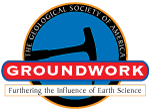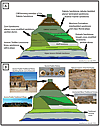Full Text View
Volume 25 Issue 8 (August 2015)
GSA Today
Article, pp. 26–28 | Abstract | PDF (212KB)
 |
| Table of Contents |
|---|
| Search GoogleScholar for Search GSA Today |
GROUNDWORK:
Connecting geology and Native American culture on the reservation of Acoma Pueblo, New Mexico, USA
Earth, Atmospheric, and Planetary Sciences Department, Purdue University, West Lafayette, Indiana 47907, USA
STEM education focused on the perspectives and needs of Native American students is a missing element in the current U.S. educational system (Barnhardt, 1997). Consequently, very few Native American students pursue careers in the STEM disciplines, especially earth science (Beede et al., 2011). Ironically, many Native American students eventually learn that earth science is a tool their ancestors used for thousands of years and that a general mastery of science and engineering skills can benefit and help maintain their communities. Most Native students, however, see no connection between Western science and the goal of preserving their cultural identities. If STEM faculty, teachers, and other scientists can better explain the links between traditional indigenous knowledge, Western science, and community needs, we contend that this approach would attract more Native American and other underrepresented students to earth science.
E-mails: ;
Manuscript received 24 Nov. 2014; accepted 28 Jan. 2015
doi: 10.1130/GSAT-G235GW.1
Earth science is especially relevant for Native communities because it ties directly into the landscape, which often has sacred implications for Native communities, and also to the natural resources that they need in order to function and prosper. An understanding of the geologic framework of tribal lands is vital not only for present-day resource management but also for future long-term decision making that will benefit future generations of Native communities. These important links between Native communities and earth science can be nurtured and strengthened by integrating them into education. Previous research has documented preliminary success in attracting Native students to geoscience courses that incorporate indigenous knowledge, Native worldviews, and culturally appropriate curricula (Semken and Morgan, 1997; Gibson and Puniwai, 2006; Palmer et al., 2009).
The purpose of this article is to present an example to the earth- science community of how a geologic discipline, in this case stratigraphy, can be presented in ways that have cultural relevance for a Native community. The example comes from the Native American community of Acoma Pueblo in New Mexico. The first author is a member of this community and grew up on the Acoma reservation. The intent of this paper is to motivate fellow earth-science faculty and teachers to explore how their research specialties can be put into cultural terms that are beneficial for a Native community. While geologic concepts are universal, cultural concepts are specific. Our approach, therefore, requires efforts to develop an understanding of a person’s culture in order to effectively communicate geologic concepts to that individual (e.g., Semken, 2005). Our example of integrating traditional knowledge (culture) and Western science is specifically for the tribal community of Acoma Pueblo, but the general approach that we advocate is applicable to other indigenous and land-based communities (e.g., Riggs, 2005).
Acoma Pueblo is a National Historic Landmark and is the oldest continually inhabited village in the United States. Generations of Acoma people have lived atop the mesa in west-central New Mexico making pottery, building their homes out of rock and mud, and farming the land at the base of the mesa. The Acoma community is literally embedded in the stratigraphy of the eastern Colorado Plateau. Knowledge of specific rocks and their uses has been passed on between generations for thousands of years. Few non-Native scientists, however, have interacted with the Acoma community and so no connection exists between the Western concept of stratigraphy and the cultural framework of the Acoma community.
Figure 1 is an example of educational material that connects the local stratigraphy (lithologies, thicknesses, and stratigraphic relationships) with Acoma cultural uses of specific geologic formations. The Western scientific viewpoint is represented by the stratigraphic nomenclature used by geologists to differentiate specific formations and their depositional environments (Fig. 1A). The Acoma Pueblo community member’s perspective of the local stratigraphy is represented in terms of cultural uses of specific intervals of the stratigraphy (Fig. 1B). Instructors can use this figure to illustrate the Western scientific concept of stratigraphy/depositional environments and immediately link this information to traditional Acoma cultural knowledge and uses of different geologic materials. After the student/community member recognizes a stratigraphic horizon with implications for the community (e.g., the formation used in the construction of their homes—the Dakota Sandstone), our intent is that they will begin to recognize the same stratigraphic horizon and its potential use in different parts of the reservation. This recognition, in turn, develops the Western scientific concept of stratigraphic correlation.
|
A comparison of the perspectives of Western earth sciences (A) and the Acoma Pueblo community (B) of the stratigraphy near Acoma Pueblo. The stratigraphic positions of earth materials that are “culturally sensitive” to the local Native communities have not been labeled in this version of the figure, because it is intended for non-tribal members. Modified from Maxwell (1976). |
Such usage would be an example of place-based education (PBE), which has been successful as a framework for teaching students from widely variable backgrounds about geologic concepts (Gruenewald, 2003; King, 2008; Semken et al., 2009; Semken and Brandt, 2010). Because PBE uses a holistic perspective, it is an effective way to combine scientific knowledge—which the student may be unaware of—with knowledge that is already within the student’s realm of cultural awareness (Barnhardt and Kawagley, 2005). For our approach, we define PBE as an educational framework that can utilize landscapes/places as mediums through which cultural traditions and Western science inform each other through the lives of people as they experience these places.
Our approach builds on the educational framework that situates learning (knowledge) in the social context of the community, the tools and practices employed, and the activity itself (e.g., Lave and Wenger, 1991). For our example, PBE requires the blending of two cultures: that of the Acoma Pueblo people and that of Western science. We feel this blending of two cultures is an especially important element of teaching earth science to Native communities. In our version of this place-based pedagogy, the instructor provides an opportunity for the student to integrate Western scientific concepts with cultural knowledge that has already been socially transferred to the student from the elders and local community. This approach, which we advocate in this article, requires earth-science instructors to put their science into a cultural perspective, which in turn requires the instructors to become familiar with their local Native communities as well as Native perspectives and uses of the local landscape. During this phase of information gathering, respect for cultural boundaries (including consent to use the traditional knowledge for teaching purposes) should be paramount. Many times, this can be achieved through close collaboration with respected Elders as well as the governing entities of particular Native communities. Building these types of relationships requires time and trust, but they can also be very rewarding and provide learning opportunities for both the students and the instructor.
In closing, it is important to note that STEM education designed for the diverse cultural needs of Native American students is lacking. The future of these students’ traditional communities is partially dependent on the strength of knowledge the community has regarding landscape uses, natural resources, geoengineering, climate change, and other aspects of earth science. The example we have presented demonstrates how to relate the concept of stratigraphy, a Western scientific construct, to the everyday lives of the Acoma Pueblo people. We contend that many similar connections between Western earth science and traditional indigenous knowledge wait to be developed with Native communities.
Acknowledgments
We thank two anonymous reviewers and GSA Today editor Steven Whitmeyer for constructive reviews. This research was supported by NSF grant GEO-0914555. We also appreciate discussions with colleagues who were part of the METALS project on how to better make earth science accessible to underrepresented students and their communities.
References Cited
- Barnhardt, R., 1997, Teaching and learning across cultures: Strategies for success: Sharing Our Pathways, v. 2, no. 2, p. 1–13.
- Barnhardt, R., and Kawagley, A.O., 2005, Indigenous knowledge systems and Alaska Native ways of knowing: Anthropology & Education Quarterly, v. 36, no. 1, p. 8–23, doi: 10.1525/aeq.2005.36.1.008.
- Beede, D.N., Julian, T.A., Beethika, K., Lehman, R., McKittrick, G., Langdon, D., and Doms, M.E., 2011, Education supports racial and ethnic equality in STEM: Economics and Statistics Administration Issue Brief no. 05-11, http://dx.doi.org/10.2139/ssrn.1934821 (last accessed 27 May 2015).
- Gibson, B.A., and Puniwai, N., 2006, Developing an archetype for integrating Native Hawaiian traditional knowledge with earth system science education: Journal of Geoscience Education, v. 54, no. 3, p. 287–294.
- Gruenewald, D.A., 2003, Foundations of place: A multidisciplinary framework for place-conscious education: American Educational Research Journal, v. 40, no. 3, p. 619–654, doi: 10.3102/00028312040003619.
- King, C., 2008, Geoscience education: An overview: Studies in Science Education, v. 44, no. 2, p. 187–222, doi: 10.1080/03057260802264289.
- Lave, J., and Wenger, E., 1991, Situated Learning: Legitimate Peripheral Participation: New York, Cambridge University Press, 138 p.
- Maxwell, C.H., 1976, Geologic map of the Acoma Pueblo quadrangle, Valencia County, New Mexico: U.S. Geological Survey Map GQ-1298, scale 1:24,000.
- Palmer, M.H., Elmore, R.D., Watson, M.J., Kloesel, K., and Palmer, K., 2009, Xoa:dau to Maunkaui: Integrating indigenous knowledge into an undergraduate earth systems science course: Journal of Geoscience Education, v. 57, no. 2, p. 137–144, doi: 10.5408/1.3544247.
- Riggs, E.M., 2005, Field-based education and indigenous knowledge: Essential components of geoscience education for Native American communities: Science Education, v. 89, p. 296–313, doi: 10.1002/sce.20032.
- Semken, S., 2005, Sense of place and place-based introductory geoscience teaching for American Indian and Alaska Native undergraduates: Journal of Geoscience Education, v. 53, no. 2, p. 149–157.
- Semken, S., and Brandt, E., 2010, Implications of sense of place and place-based education for ecological integrity and cultural sustainability in diverse places, in Tippins, D.J., Mueller, M.P., van Eijck, M., and Adams, J.D., eds., Cultural Studies and Environmentalism: Cultural Studies of Science Education, v. 3, p. 287–302, doi: 10.1007/978-90-481-3929-3_24.
- Semken, S., and Morgan, F., 1997, Navajo pedagogy and earth systems: Journal of Geoscience Education, v. 45, p. 109–112.
- Semken, S., Freeman, C.B., Bueno Watts, N., Neakrase, J.J., Dial, R.E., and Baker, D.R., 2009, Factors that influence sense of place as a learning outcome and assessment measure of place-based geoscience teaching: Electronic Journal of Science Education, v. 13, no. 2, p. 136–159, http://ejse.southwestern.edu/article/view/7803/5570 (last accessed 27 May 2015).

 Figure 1
Figure 1